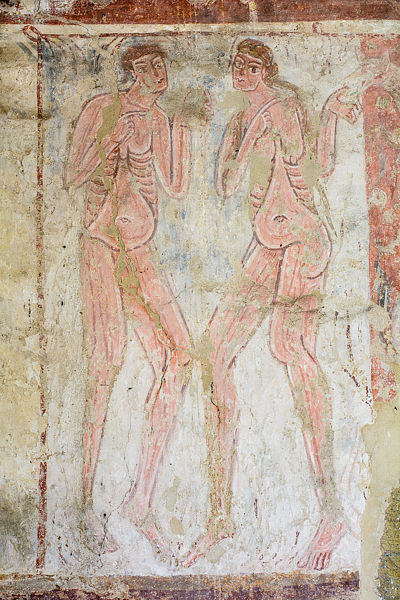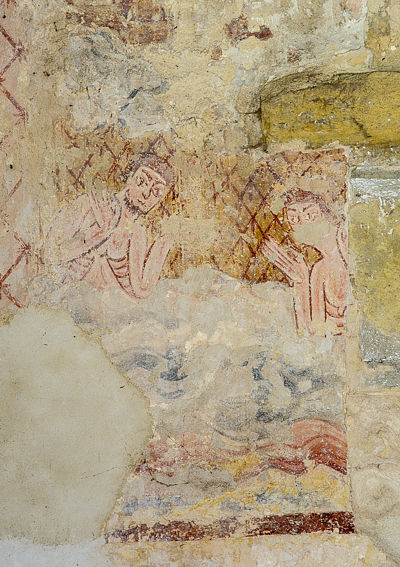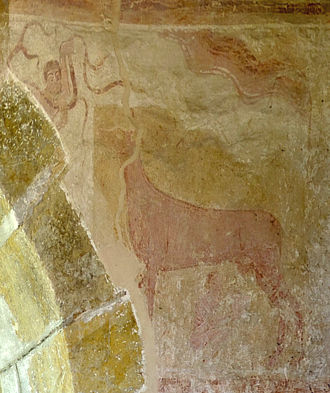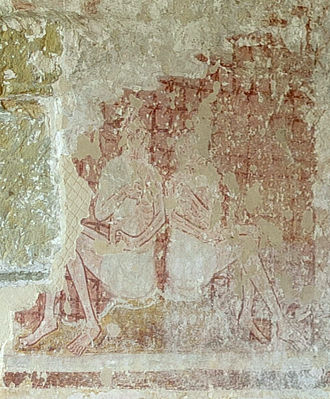Hardham, Sussex (†Chichester) C.12
The Fall and its Aftermath

These extraordinary paintings are in the chancel at Hardham, on the chancel side of the chancel arch wall and thus facing the high altar. This depiction of Adam and Eve about to yield to temptation at the left was dated, like all the Hardham paintings, at about 1125 by EW Tristram¹ and it is one of the most remarkable medieval paintings anywhere. Most of the other paintings here, Tristram thought, show the kind of French influence to be expected in 12th century paintings, but he believed this one in particular to be a deliberate continuation of the Anglo-Saxon tradition, so close are the rememblances to manuscript painting such as that in the Caedmon MS in the Bodleian Library, Oxford².

Adam stands at the left, hands apprehensively raised. Beside him, Eve reaches out to take the fatal Apple from a winged, dragon-like creature who has been compared to a wyvern. Other details at the far right are now very faint, but they originally showed the Tree of Life, on which the wyvern-creature seems to be perching.
Both figures are of course naked, and it seems to me that the painter changed his mind, perhaps more than once, about how the figures were to be disposed in the space – there are some pigmented lines and areas between Eve’s feet which suggest that she might originally have been sketched in further left. Whereas the other paintings in the chancel at Hardham are framed within illusionistic architecture, here on the west wall there are traces of painted loops at the top, and (in this scene specifically) a reddish vertical band at the right, perhaps intended for a curtain, with a hook painted above the Tempter. The intention, again according to Tristram, may have been to differentiate this painting from the others from the start.
Below this scene, and pictured at the right, is the next, a very rare painting of Adam and Eve bathing³ (and not, as Tristram thought, the Expulsion). Stylised red waves show at the bottom, and the general pattern of these can still be seen higher up, where the red pigment has disappeared. The figures of Adam and Eve, only partly visible now, stand in front of a lattice pattern, and there is a broader band of diamond-shaped lattice to the left.
It is hard to know what to make of these details in what ought to be an outdoor scene (the possibility that Adam and Eve are trying to hide their nakedness from God occurs to me, but I am not entirely happy with the idea). But the larger and subsuming difficulty lies in deciding whether this bathing takes place before or after the Fall. Placing an earlier event in a lower position on the wall than a later one is not particularly unusual in English Church painting, but whether this is Adam and Eve in their innocent Prelapsarian state or in their fallen state of knowledge seems to me well-nigh impossible to prove. Their raised hands might indicate consternation, but the fact that they are not attempting to hide their nakedness (perhaps because it is hidden by the water?) argues against this. A conundrum which only comparison with a similar and contemporary painting of the subject would, or might, clarify.

Pictured at the left is the uppermost scene on the right-hand side of the chancel wall, where the story of the aftermath of the Fall continues. A large quadruped, facing left, fills most of the space, and between its fore and hind legs squats Eve, very faint, apparently milking it. The identity of this animal is another subject for conjecture. Tristram thought, reasonably enough, that it might be a goat, and there is something about the shape of its eye (visible only as a whitish oval now) that would support this idea. But its large size and generally undomesticated, even slightly sinister, appearance perhaps suggest it as principally a symbol of the Fall and the damage done to Adam’s God-given lordship over the beasts in Genesis 1:28.

At all events, the figure peering between branches at the top left of the painting seems to be Adam, possibly pausing in his pruning of the tree to look at Eve and the animal below. The wavy red band at the top right looks like water again, and it might be one of the four rivers into which that flowing out of Eden in Genesis 2:10 divided, used here to indicate Eden’s boundary.
Below the scene with Eve and the animal is the one pictured right here, showing Adam and Eve seated together. There is little left of their faces, but the disposition of their arms and legs eloquently expresses their shame. At the top of the painting is a separate, smaller scene; it is just possible to make out an implied row of figures – at least four, I think – and this might well be the Expulsion from Paradise. These scenes on the right reinforce my belief that all four on this wall are to be ‘read’ from bottom to top and left to right – bathing scene, temptation by the wyvern-bird, acknowledgment of shame (this scene), Expulsion (very indistinct as described above), and accommodation to a new relationship with the created world in Eve’s milking and Adam’s pruning.
This is merely one of the shorter walls at Hardham, which is fully painted throughout. Not everything is clear, but more paintings from the church, starting with the Annunciation, Visitation and Nativity are now here, and others will follow. Since the Hardham chancel falls into more than one category, Links to tables for other Genesis Scenes and for Very Early Painting are below.
¹ Tristram 1, p.131-133
² Drawings from the Bodleian Caedmon MS (Bodleian MS Junius 11) are available on the web ( Bodleian Library, Oxford) and a good image for comparison with this one is on page 31. Go to the section “Early Manuscripts at Oxford University”, click ‘Bodleian Manuscripts’ in the left-hand panel, and find MS Junius 11 in the alphabetical list But be warned – the images are very large (and copyright).
³ ‘Adam and Eve and Pinch-me went down to the sea/river to bathe…’. Where does this children’s rhyme come from? How old is it? Ideas welcome.
You can see a 360° panoramic tour of the interior of the church here.
Website for St Botolph’s, Hardham
Photos © Roy Reed 2019